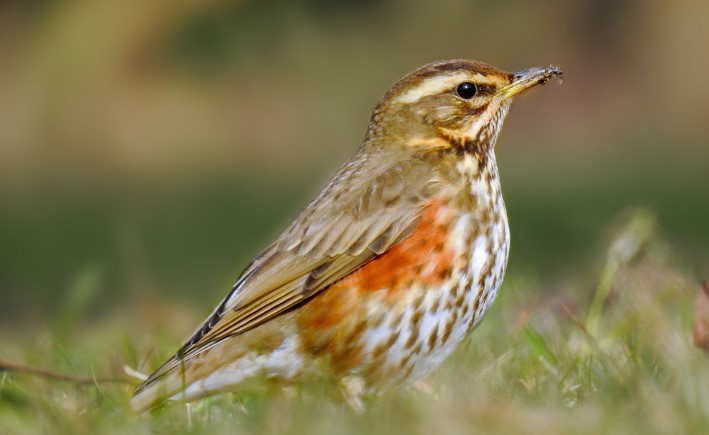The redwing (Turdus iliacus) measures 21–24 cm in length, has a wingspan of 33–35 cm, and weighs 55–75 grams. Easily distinguished from all of these by its pale supercilium and half-collar, along with its rusty-red flanks, it is the smallest resident thrush of the European region. It belongs to the Turdidae family of birds and is native to Europe and the Palearctic. It is slightly smaller than its relative, the song thrush.
Compared with the Song Thrush, it is slightly smaller and has a shorter tail. The upper parts are darker and supercilium, and the lower border of ear coverts (forming half-collar) is whitish. The underparts are heavily streaked. On the breast, streaks merging into dark patches often appear orange-buff on the underparts. Folded wings may partially conceal warm, reddish flanks, which are often obvious. In some cases, the wing can appear quite contrasting, with paler and darker shades of brown. There may also be reddish underwing coverts visible in flight.
Probably confused with vagrant Eyebrowed and Dusky. At other times of the year, they gather in large groups in open country, particularly during the breeding season. The flight of the redwing bird is fast and direct. There is often a high level of flight in flocks. Open ground, bushes, or trees are the places where it feeds. Birds of this species are generally shy and wary.
During juvenile life, the underparts of the bird have more rounded spots, and the upper parts are streaked with buff. The tips of tertials and greater coverts of many first years have whitish spots due to retained juvenile feathering, while other first years may not be old enough to be safely fed. It is common for migrants to feed together with fieldfares, common blackbirds, and starlings, and sometimes with mistle thrushes, song thrushes, and ring ouzels during migration and wintering.
Males sing a variety of short songs and whistle during flight. Redwings have distinct dialectic variations in their songs, with considerable similarity between birds within the same local population. Typical redwing calls are thin, indrawn, penetrating ‘seeehs’ or ‘seeips’ uttered in flight, often from migrating flocks at night.
It produces a hard, rattled ‘chittick’, as well as a soft, muffled ‘chup’ or ‘kuk’. Redwing songs are typically composed of three or four descending flute-like notes followed by a prolonged but subdued twittering. An example of an introductory note is ‘chirre cherre churre’, ‘tree triu tru tro’, and a faster ‘teechee-teechiu’. Sometimes a more varied song is given, reminiscent of a weak song thrush.
There are slight geographical variations between the two races (nominate illustrated). In the race coburni (Iceland and Faeroes), the underparts are particularly dark, washed brownish, and rich buff, and the streaking is more extensive and intense than in the nominate race. The redwing bird is common and abundant locally.
The species has been bred in Denmark, Germany, Czechoslovakia, Austria, and Italy, in addition to the mapped range. In the open tundra, it breeds in banks and rocky areas; locally, in parks and gardens, in various types of woodland, and in birch and willow scrub. At times of severe cold, it moves into gardens only when breeding season is over. Found primarily in open farmland but also at woodland edges.







